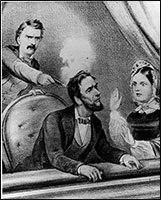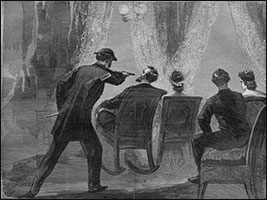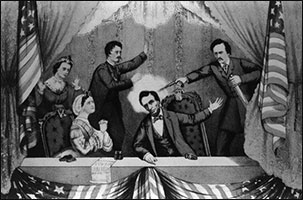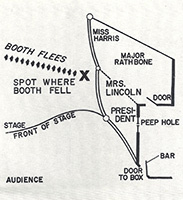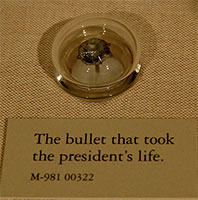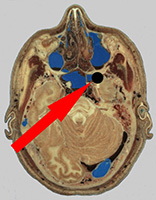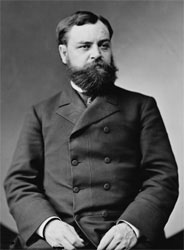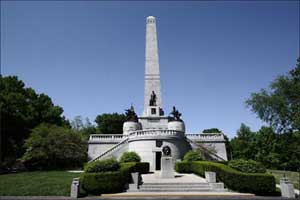| "HELLCAT" MARY LINCOLN USED A DERRINGER PISTOL TO KILL ABE AND THE "PINK PANTHER" USED A BERETTA PISTOL TO KILL JACK. |
Here is a brief quote from a biography of John Hay—private secretary and assistant to President Lincoln:
So much grief to bear, even here at the pinnacle of Mary Todd Lincoln's glory, and after so long at her lowly, lonely chores back in Springfield. And the griefs ahead for the woman! One must feel for her; yet to Nicolay and Hay on the scene, dealing with Mrs. Lincoln day by day she had made herself into a "Hell-Cat," into "Her Satanic Majesty." They couldn't stand her. (McFarland, John Hay: Friend of Giants, p. 41).
There are amazing similarities between the Kennedy and Lincoln assassinations. The conspirators who planned the Kennedy assassination were thoroughly familiar with the previous assassination.
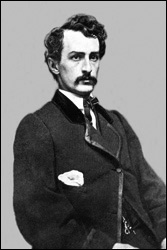 John Wilkes Booth (1838 - ????). |
|
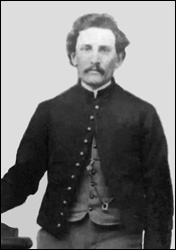 James William Boyd (1822–1865). |
Secretary of War Edwin Stanton was the overseer of the assassination. Stanton was in charge of the secret police and the telegraph office, with his assistant, Major Thomas T. Eckert.
Before going to the theatre, Lincoln asked for Major Eckert to be his bodyguard, but Stanton refused saying that Eckert was "busy" that night. President Lincoln was surrounded by Confederate traitors and it is a miracle that the New Jerusalem survived!
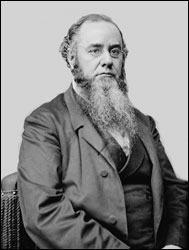 Secretary of War Edwin M. Stanton (1814 –1869). |
|
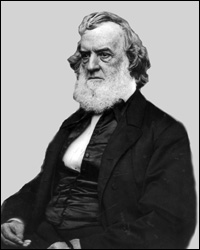 Navy Secretary Gideon Welles (1802–1878). |
Union Admiral Lee made sure that Richmond remained the rebel capital until 1865. "U.S." Grant was another major conspirator. Grant's real name was Hiram Ulysses Grant (H.U.G) but his malicious schoolmates called him "Ulyss" or "Useless." When he enrolled in the West Point Military Academy in 1839 his name was changed to Ulysses S. Grant "U.S." Grant. "Useless" Grant certainly HUGGED the Confederacy during the Civil War!
On March 2, 1864, Lincoln promoted "Useless" Grant to lieutenant general, giving him command of all Union Armies. That was a disastrous appointment for the Union because "Useless" was well known to be a drunk!
After the great victories at Gettysburg and Vicksburg, the war should have been over in 1863. Grant deliberately prolonged the deadly conflict so that Lincoln would lose the 1864 election.....There was even talk of "Useless" running for President.
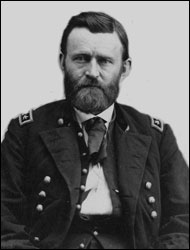 "Useless" Grant (1822–1885). |
|
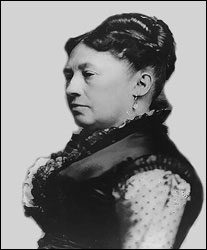 Cross-eyed Julia Grant (1826–1902). |
Here is a brief quote from a massive 1074-page biography of "Useless" Grant:
Lincoln urged Grant to accompany him to the theater, hinting that the nation expected to see the victorious president and general united at such a moment. Having just been in the public spotlight, Grant wished to escape town. At this awkward moment, a message from Julia arrived, listing her reason for wanting to set out for Burlington in the late afternoon. Fortified with these excuses, Grant politely declined to attend Ford's Theatre, joking that he now had a command from Mrs. Grant. (Chernow, Grant, p. 523).
Incredibly, on their way to the train station a man who looked like Booth stopped their carriage and peered inside to make sure they were on their way!
Samuel Clemens, aka Mark Twain, wrote and published the Memoirs of Civil War General Ulysses S. Grant because "Useless" couldn't put 2 sentences together. Virginian General George Thomas (1816 – 1870) was the real hero of the Civil War, but he was assassinated before he could run for President in 1872.
Shake-spearean actor John Wilkes Booth was supposed to be the fall guy or patsy for the assassination. No male would walk into a crowded theater armed only with a single shot derringer pistol and a knife!
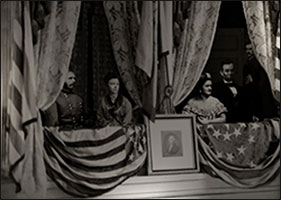 Abe and Mary "together" at Ford's Theatre. |
|
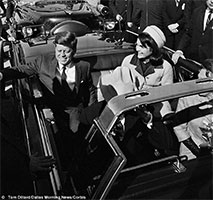 Jack and Jackie "together" in their limousine. |
At the end of the Civil War, firearms were available everywhere in Washington City. If John Wilkes Booth had intended to shoot the President, he would have used a six-shooter.
The small pistol that Mary used to kill her husband was called a derringer, after its inventor, John Derringer. That pistol was deadly only at very close range and it contained just a single .44 caliber bullet. The Presidential box was DARK inside and that left absolutely no margin for error.
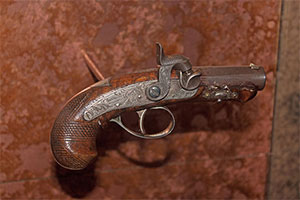 Mary's small derringer pistol which she used to kill her husband. |
|
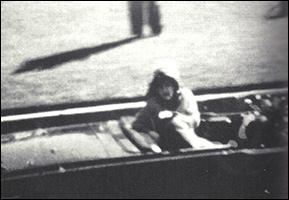 Jackie shooting Jack behind his left ear. |
When Dr. Charles Leale arrived in the Presidential box, Mary was holding her husband erect to hasten his death. After the first shot by Killerman, the President slumped over and Jackie held him erect for her shot to his left ear.
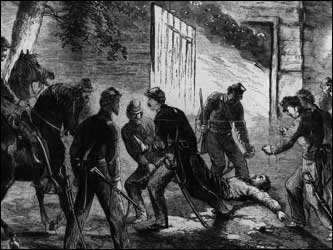
Captain Boyd was killed in the barn.
|
|
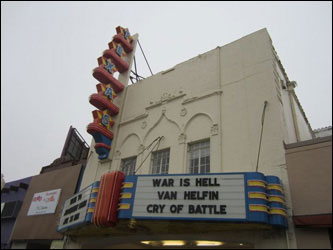 The Osward double was supposed to be killed in the Texas Theater. |
Dr. Charles Leale moved the President's body out of the theater to a house across the street from Ford's Theatre. There the President went to his eternal reward at 7:22 a.m., on Saturday, April 15, 1865.
President Lincoln's body was viewed in the East Room of the White House and then moved to the Capitol Rotunda. That was the exact pattern followed by the Kennedy funeral.
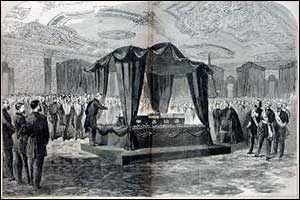 President Lincoln's body lying in state in the East Room of the White House. |
|
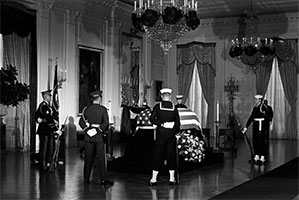 President Kennedy's body lying in state in the East Room of the White House. |
Millions mourned the death of the President and he was finally laid to rest in Springfield, Illinois. President Kennedy is buried in Arlington National Cemetery, the former home of arch rebel Robert E. Lee.
Dr. Charles Leale said that Lincoln was shot behind his left ear!!
Dr. Charles Leale was the first physician on the scene after the assassination. He entered the darkened box and saw Mary holding the President's head erect.
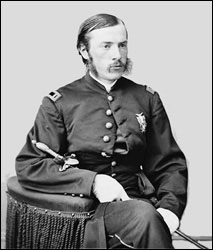 Dr. Charles Leale (1842–1932). |
|
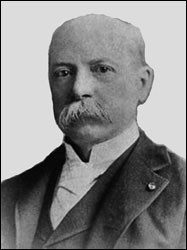 Dr. Charles Leale circa 1908. |
Dr. Leale was an experienced army surgeon and very familiar with gunshot wounds:
When I entered the box, Mr. Lincoln was sitting in a high backed armchair with his head leaning towards his right-side and which was supported by Mrs. Lincoln who was weeping bitterly. Miss Harris was at her left-side behind the President, Major Rathbone was at the door of the box. (Good, We Saw Lincoln Shot, p. 60).
Mary did not tell him where she had shot her husband, so he searched frantically for the fatal wound:
With the assistance of two gentlemen I immediately placed him in a recumbent position while doing this and holding his head and shoulders my hand came in contact with blood on his left-shoulder, the thought of the dagger then recurred to me, and supposed that he might have been stabbed in the subelavical artery or some of its branches. I asked a gentleman near by to cut his coat and shirt off that shoulder to enable me if possible to check the supposed hemorrhage, as soon as his arm was bared to a distance below the shoulder, and I saw that there was no wound there, I lifted his eyelids and examined his eyes, the pupil of which was dilated. I then examined his head and soon discovered a large firm clot of blood situated about one inch below the superior curved line and an inch and a half to the left of the median line of the occipital bone. (Good, We Saw Lincoln Shot, p. 60).
Dr. Leale said that the President would have died in 5 minutes if he had not laid him down on the floor:
I believe that he would not have lived five minutes longer if the pressure on the brain had not been relieved and if he had been left that much longer in the sitting posture. (Good, We Saw Lincoln Shot, p. 61).
Dr. Leale was so horrified at what he saw that he refused to talk about it for the rest of his long life. In 1909–the centenary of Lincoln's birth–he gave a speech about the events of that fateful night, which was published in Harper's Weekly. The speech was entitled Lincoln's Last Hours:
I supposed the President had been stabbed, and while kneeling on the floor over his head, with my eyes continuously watching the President's face, I asked a gentleman to cut the coat and shirt open from the neck to the elbow to enable me, if possible, to check the hemorrhage that I thought might take place from the subclavian artery or some other blood vessel. This was done with a dirk knife, but no wound was found there. I lifted his eyelids and saw evidence of a brain injury. I quickly passed the separated fingers of both hands through his blood matted hair to examine his head, and I discovered his mortal wound. The President had been shot in the back part of the head, behind the left ear. I easily removed the obstructing clot of blood from the wound, and this relieved the pressure on the brain. (Leale, Lincoln's Last Hours, p. 5).
The doctor's heroic efforts saved the President from dying in a theater. At that time, most Christians in the New Jerusalem associated the theater with a bawdy house!
Dr. Leale was not called to testify at the trial of the conspirators. His evidence would have sent Mary Lincoln to the gallows . . . instead of Mary Surratt.
The Lincoln autopsy showed the bullet lodged behind his right eye!!
As with the Kennedy autopsy, there was a storm of controversy over the Lincoln autopsy. Mary's pistol fired a .44 caliber bullet, which always traveled in a straight line when it exited the pistol barrel.
|
|
|
|
Another representation shows Booth holding the derringer in his right hand . . . while he holds the daggar in his left hand.
|
|
|
Lincoln was sitting close to the left wall and only Mary had access to him from that side. She simply leaned over and shot her husband with the pistol in her left hand.
The 3 representations of "Booth" shooting the President are false . . . but they represent the divergent views of the doctors who observed the autopsy. Major Rathbone did sit on a sofa to the right and he would have instantly noticed any unauthorized intruder. The derringer was only deadly at very close range and nobody remembers Booth ever practicing with a derringer.
|
|
|
The autopsy of the President was performed by army surgeons J. Janvier Woodward and Edward Curtis:
Dr. Woodward, who did the autopsy, and Dr. Curtis, who assisted, stated that the ball traversed the open space in the left side of the brain and came to rest over the left eye. However, Dr. Barnes, the Surgeon General, and Dr. Taft, who was the second doctor to reach Lincoln (having been boosted upward from the stage over the edge of the box), both stated positively at the trial of the conspirators, and later, that it ended up over the right eye. Moreover, there were conflicting statements, by two different observers, as to which pupil was large and which pupil was small. (Lattimer, Kennedy and Lincoln: Medical and Ballistic Comparisons of their Assassinations, p. 39).
Dr. Taft, who was the second doctor on the scene after Dr. Leale, observed the autopsy. He stated emphatically that the ball traversed his brain from left to right:
The calvaria was removed, the brain exposed, and sliced down to the track of the ball which was plainly indicated by a line of coagulated blood, extending from the external wound in the occipital bone, obliquely across from the left to right through the brain to the anterior lobe of the cerebrum, immediately behind the right orbit. The surface of the right hemisphere was covered with coagulated blood. After removing the brain from the cranium, the ball dropped from its lodgment in the anterior lobe. A small piece of the ball evidently cut off in its passage through the occipital bone, was previously taken out of the track of the ball, about four inches from the external wound. The hold made through the occipital bone was as cleanly cut as if done with a punch. (Dr. Taft, Philadelphia Medical Reporter, April 22, 1865).
Surgeon general Joseph K. Barnes, was also present at the autopsy, and he testified at the military tribunal trial that the ball lodged behind the President's right eye.
Booth escaped and a double was killed in his place!!
Actor John Wilkes Booth could afford to be the fall guy or patsy for the assassination because the conspirators had a look-alike or double ready to be killed in his place.
If Booth wanted to kill the President in the darkened theater, he would have used a Colt six-shooter, and not a single shot derringer pistol. Booth was assisted in the Presidential box by 2 more accomplices.
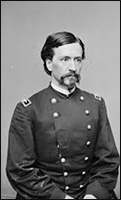 Major Henry R. Rathbone (1837–1911). |
|
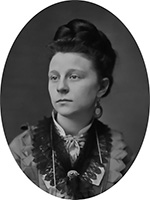 Clara Harris (1834–1883). |
On December 23, 1883, Rathbone attacked his children in a fit of madness. Rathbone fatally shot and stabbed his wife, who was attempting to protect the children. Rathbone then stabbed himself five times in the chest in an attempted suicide. He was charged with murder but was declared insane by doctors after blaming the murder on an intruder. He was convicted and committed to the Asylum for the Criminal Insane in Hildesheim, Germany. The couple's children were sent to live with their uncle, William Harris, in the United States.
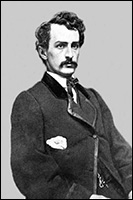 John Wilkes Booth (1838 - ????). |
|
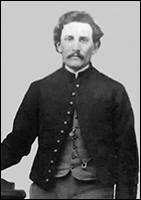 James William Boyd (1822–1865). |
It is a known fact that the British Secret Service has employed doubles for centuries. The current President of Russia is a Putin look-alike or double.
After the assassination, fake fall guy Booth lived on his farm in the Shenandoah Valley in Virginia. When all the furor over the assassination had died down, he left for Canada, and eventually he moved back home to London.
It is possible that he expected the Civil War to resume shortly. Then he and Mary Lincoln would be hailed as heroes if the South won round two.
The wrong Mary was hanged for killing President Lincoln!!
Mary Surratt was the first woman to be hanged in the United States. She was also a devout member of the Latin Church. She was convicted mostly on the testimony of Louis Weichmann. Weichmann was studying to be a priest and he certainly was of the same faith as Mary Surratt.
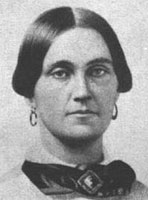 Mary Surratt (1823–1865). |
|
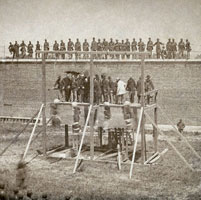 Execution of Lewis Paine, George Atzerodt, David Herold, and Mary Surratt. |
The people who should have joined Mary Lincoln on the scaffold were: general Robert E. Lee, Jefferson Davis, Judah P. Benjamin, Vice President Johnson, general Grant, Edwin Stanton, Benjamin Butler, major Henry Rathbone, and Clara Harris, etc., etc, etc.
A jury of her peers committed Mary to an insane asylum in May 1875
Unlike Jackie Kennedy, Mary did not have a priest to absolve her for the murder of her husband. Murder is a terrible crime, no matter what the social status of the person. Murdering her own husband, who labored for 4 long years to save the Union, made her inconsolable.
|
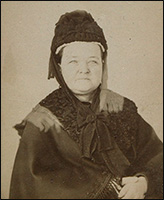 Mary Lincoln (1818–1882). |
The insane verdict actually helped Mary, because, if she was charged with her husband's murder, it would have saved her from the hangman's noose. Mary was also a compulsive shopper and she was squandering all her money and going deeply into debt. Robert's only option to prevent her from killing herself was to have her committed.
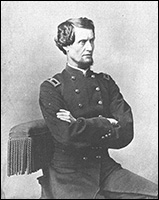 Judge R.M. Wallace presided over the insanity trial. |
|
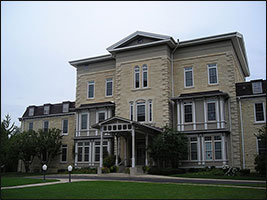 The Batavia Institute in Batavia, Illinois. |
Before she was committed, Mary tried suicide again by ordering a bottle of laudanum from the local drug store:
To make sure he filled the order properly, Mrs. Lincoln stepped behind the counter to watch. Squair was at his wits' end. He had sent for Robert Lincoln after Mrs. Lincoln's departure with the first drug order, but he had not yet arrived. The druggist told his troubled customer that he kept the laudanum in the cellar and went downstairs, where he poured an ounce of burnt sugar and water into a vial and labeled it "Laudanum-poison." Mary drank it right after leaving the store and went to her room to die."
Robert soon arrived, and his mother had to give up her attempts at suicide. He and Swett remained with her through the night. Serene resignation reminiscent of her courtroom appearance characterized her preparations to travel to Batavia the next afternoon. (Neely, The Insanity File, p. 35).
Mary only spent 4 months in the asylum. As usual, the news media painted Robert in the worst possible light, and the judge agreed that she should be released in the custody of her sister, Elizabeth Todd Edwards.
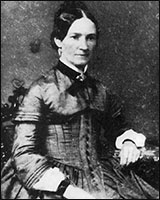 Elizabeth Todd Edwards (1818–1888). |
|
Here is an account of pistol-packing Mary's attempt to shoot her son too:
"I am sorry to say that your mother has for the last month been very much embittered against you, and has on several occasions said that she has hired two men to take your life," Ninian Edwards wrote Robert in mid-January. "On this morning we learned that she carries a pistol in her pocket....She says she will never again allow you to come into her presence. We do not know what is best to be done." The next day, Robert's uncle wrote that Elizabeth thought she could get the gun away from Mary. But one day later, Elizabeth suggested that Robert write to his mother and confront her about it; this would give Ninian an excuse to demand the weapon without either of the Edwardses incurring her wrath. "Your uncle is perhaps unnecessarily excited upon the subject of the pistol," Elizabeth wrote in her typical attempt at conciliation. "There may be danger to herself and others."' She suggested, again, that only the return of her bonds would alleviate Mary's anger. (Emerson, The Madness of Mary Lincoln, p. 109).
Mary did not have a chance to fulfill her threat to kill Robert as he lived to a ripe old age.
During the early 1880s, Mary was confined to the Springfield, Illinois, residence of her sister Elizabeth Edwards. On July 16, 1882, she collapsed at her sister's home, lapsed into a coma, and died that same day at age 63. She was interred in the Lincoln Tomb in Oak Ridge Cemetery in Springfield alongside her husband.
Chernow, Ron. Grant. Penguin Press, New York, 2017.
Emerson, Jason, The Madness of Mary Lincoln. Southern Illinois University Press, Carbondale & Edwardsville, Illinois, 2007.
Good, Timothy Sean. We Saw Lincoln Shot. University Press of Mississippi. Jackson, Mississippi, 1995.
Lattimer, Dr. John K. Kennedy and Lincoln Medical and Ballistic Comparisons of their Assassinations. Harcourt Brace Jovanovich, New York, 1980.
MacFarland, Philip. John Hay, Friend of Giants. Rowman & Littlefield, Lanham, Maryland, 2017.
Stephens, Caleb Jenner. Worst Seat In The House: Henry Rathbone's Front Row View of the Lincoln Assassination. Willow Manor Publishing, Fredericksburg, Virginia, 2014.
Leale, Dr. Charles. Dr. Leale's Letter.
Leale, Dr. Charles. Lincoln's Last Hours.
Neely, Mark E, The Insanity File: The Case of Mary Todd Lincoln. Southern Illinois University Press, Carbondale & Edwardsville, Illinois, 2007.
Testimony of Dr. Taft from the Philadelphia Medical Reporter, April 22, 1865.
Copyright © 2016 by Patrick Scrivener
